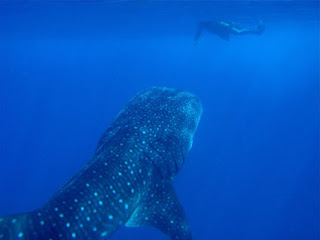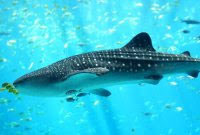磁石で引っ張られるかのように、あっという間に体は空高く引き上げられた。Microlight に乗った。正直、空中の乗り物は苦手だが、眼下に広がる風景は、緊張を一瞬にしてほぐしてくれるほど美しく、そして刺激的なものだった。
午前中の調査では、パイロットが特定のエリアにおける海況情報とジンベイザメをはじめとする生物の位置を記録していく。
飛行してすぐ、ジンベイザメを発見。その光景は、とても印象的だった。
上空から見下ろすジンベイザメと彼らを取り巻く大洋の対照的な大きさ。広大な大洋に落とされた一滴のインクのように小さなジンベイザメ。それは、かすかにその姿を確認できるほどのものだ。
私が心奪われたのは、そんなジンベイザメの小ささよりも、むしろ限りなく広がる大洋だった。豊富な栄養分を含んでいることを想像させるようなたっぷりとあ ふれんばかりの水をたたえた大洋。そう、ジンベイザメはその中で生きているんだ。当たり前のことかもしれないが、その光景は、ジンベイザメと彼らを取り巻 く環境の関わり、本質的なつながりを強く意識させるものだった。
 船上で行われるCTDや プランクトン採集、サッキーディスクといった環境モニタリングから得られるデータの一つひとつは、ジンベイザメ(ジンベイザメの分布)と彼らを取り巻く環 境の関係への興味を大いに駆り立ててくれるものだが、上空からのその光景はその一つひとつの情報をより全体的な視点で捉えさせてくれるものだった。
船上で行われるCTDや プランクトン採集、サッキーディスクといった環境モニタリングから得られるデータの一つひとつは、ジンベイザメ(ジンベイザメの分布)と彼らを取り巻く環 境の関係への興味を大いに駆り立ててくれるものだが、上空からのその光景はその一つひとつの情報をより全体的な視点で捉えさせてくれるものだった。
今 年は、ジンベイザメがなかなか姿を現さない。セーシェル周辺にはもういないのか、それとも私たちの目の届かない深場に隠れているのか。彼らを取り巻く環境 に何が起こっているのか、正直私にはわからない。しかし、環境を観察することは、そのなぜに答えるアイデア(ヒント)を示してくれる。
午 後のフライトでは、ボートのために、ジンベイザメを探すことに専念。目をこらして探すも、なかなか見つからず、さらに雨も降ってきた。気分も下がり始める 頃、雨雲と雨雲の雲の切れ間から突然、虹の輪が現れた。それは、美事な円を描き、輝くほど鮮やかな七色。息を呑むほど本当に美しい光景だった。
こ れまで同じ状況下で数え切れないほどその美しい姿は上空に現れていたのだろう。しかし、それが誰かに見られることはきわめて稀なことだ。その瞬間に居合わ せた偶然がたまらなくうれしかった。予期せぬ自然の偶然の出来事に触れることは、体中にじわじわと染み渡るような暖かい喜びだ。
ジ ンベイザメと出会うということもまた、同じだ。たとえホットスポットがあろうと、私たちが水中でその姿に出会うということは、ジンベイザメが水面に姿を現 し、パイロットがあるいは船がその姿を確認できる場所にいる、そして私たちがそんな瞬間に居合わせる偶然の出来事なんだろう。
数え切れないほど彼らと出会っていても、それでも飽きることなく彼らとの出会いに心躍るのは、ジンベイザメそれ自身の美しさと、その出会いが自然の中の偶然の出来事だからだろう。
このプログラムを通して行った環境モニタリングやMicrolight からのサーベーは、より広い視点で対象を見ることの面白さを教えてくれる貴重な体験だった。
My body went straight up into the sky like a flash, as if pulled up by a magnet. I was on the micro-light. To be honest, I don’t like any aircrafts but the view stretching out below me was so beautiful and exciting that it made my stress melt instantly.
On the morning survey, the pilot logs environmental data and the locations of not only whale sharks but also other interesting creatures in a particular area.
We found a whale shark as soon as we took off. The sight from the sky fixed my attention, there was such a contrast between the size of the shark and the ocean surrounding it. The whale shark was tiny like a drop of ink dripped into the vast ocean, so small it was barely recognisable.
I was so impressed by the ocean spreading out without limit rather than the tiny size of the whale shark, it is no wonder that the sharks live in it. It was this sight that has made me acutely aware of the relationship between the whale sharks and their surrounding environment and that they are essentially linked.
The data from environmental monitoring on the boat, such as CTD profiles, plankton tows and the Secchi disk had peaked my interest into the correlation between whale sharks (or their distribution) and the environment. However it was still just data to me, but the sight from the sky has put it all into perspective on a global scale.
Whale sharks haven’t appeared easily this year. Have they not been here or are they just hiding in deep water? To be honest I have no idea, but by monitoring the environment it allows my imagination to find possible reasons why.
( it shows me some hints / idea to find possible reason why.)
During the afternoon flight, we concentrate on finding whale sharks for our boat. The pilot and I had made every effort to find whale sharks but we couldn’t. To make matters worse, it had started to rain. Just as I was beginning to feel down, a rainbow ring suddenly appeared through a break in the rain clouds. It was a perfectly circular, vivid and brightly iridescent. It was an absolutely beautiful scene.
Undoubtedly these beautiful rainbows appear all the time in the right conditions but are rarely witnessed, being there at just the right moment made me so happy. It was so unexpected that I could feel the joy spreading gradually through my body.
To me encountering whale sharks in the water is the same as this. Even though we know where to concentrate our search, to actually get to swim with the sharks requires so many things to be just right, the pilot and boat has to be in exactly the right place at the right time so each encounter is still down to chance.
Even though I have a lot of experience swimming with whale sharks, I have never become tired of it and still I enjoy it. Not only because of their immense beauty, but also that I am part of one of nature’s chance encounters.





















